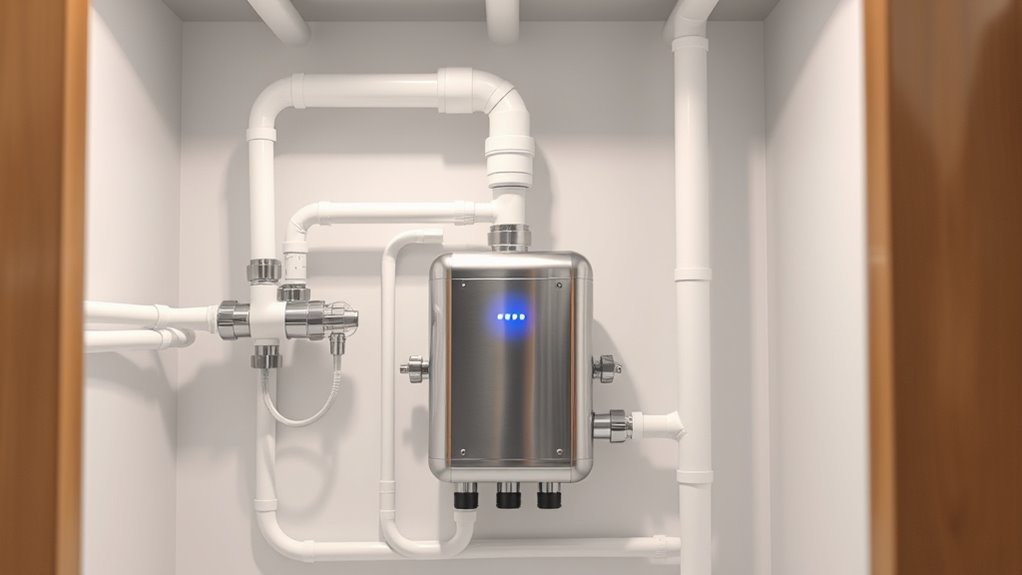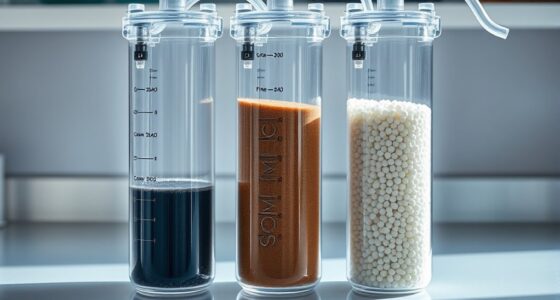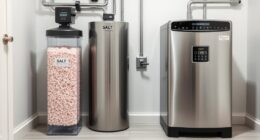To integrate a UV sterilizer into your whole house system, install it after your main water filter, making sure it treats all incoming water. Regularly replace the UV bulb every 9 to 12 months to keep it effective, and clean the quartz sleeve to prevent buildup. Monitor water flow and quality to maintain system performance. If you want detailed steps and tips, there’s more to explore to guarantee ideal setup and maintenance.
Key Takeaways
- Evaluate your home’s water quality and flow rate to select an appropriately sized UV sterilizer system.
- Install the UV sterilizer at the main water entry point for comprehensive whole-house treatment.
- Ensure proper electrical wiring and grounding for reliable UV bulb operation and safety.
- Regularly maintain and replace UV bulbs and clean quartz sleeves to sustain sterilization efficiency.
- Integrate system monitoring and flow control devices to optimize performance and prevent microbial contamination.

Integrating UV sterilizers into your water treatment system can considerably enhance its effectiveness by destroying bacteria, viruses, and other harmful microorganisms. When you add a UV sterilizer, you’re taking a proactive approach to ensuring your household water is safe and clean. However, to keep it operating at its best, regular system maintenance is essential. One key aspect of system upkeep is UV bulb replacement, which ensures your sterilizer continues to emit the proper UV wavelength needed to neutralize pathogens effectively.
UV bulbs gradually lose their germicidal power over time, even if they still light up. So, sticking to a schedule for UV bulb replacement is crucial. Typically, bulbs are rated for about 9 to 12 months of effective use, but this can vary depending on the manufacturer and water conditions. Failing to replace the bulb on time can lead to a drop in sterilization efficiency, leaving your water vulnerable to microbial contamination. To avoid this, mark your calendar or set reminders for regular inspections and bulb changes.
Replace UV bulbs every 9 to 12 months to maintain sterilization efficiency and keep your water safe.
System maintenance goes beyond just changing the UV bulb. You should also routinely check the quartz sleeve that encases the bulb, as mineral deposits or dirt can reduce UV transmission. Cleaning this component with a soft cloth and mild cleaning solution helps maintain optimal performance. Additionally, inspect the overall system for leaks, ensure the flow rate matches the manufacturer’s specifications, and verify that the power supply is stable. These steps help prevent issues that could compromise the sterilizer’s effectiveness. Proper maintenance also includes monitoring the water quality, as the presence of sediments and minerals can impact UV performance.
Integrating UV sterilizers into your whole house water system isn’t a set-it-and-forget-it task. It requires ongoing attention to detail. Regular maintenance routines not only prolong the lifespan of your equipment but also ensure your water remains safe for everyday use. Remember, neglecting UV bulb replacement or failing to keep the system clean can undermine the sterilizer’s purpose, exposing your household to potential health risks. Staying diligent with maintenance means you can confidently enjoy the benefits of purified, pathogen-free water at all times. Proper upkeep may seem minor, but it plays a vital role in the overall performance and reliability of your UV sterilization system.
Frequently Asked Questions
What Maintenance Schedule Is Recommended for UV Sterilizers?
You should replace the UV bulb every 12 months to guarantee maximum sterilization. Regularly flush the system every six months to clear any mineral buildup or debris that could reduce effectiveness. Check the UV sterilizer’s quartz sleeve for cleanliness and clean it as needed. Monitoring the bulb’s performance and replacing it promptly helps maintain water quality. Consistent maintenance keeps your whole house system running smoothly and effectively.
Can UV Sterilizers Treat All Types of Water Contaminants Effectively?
Think of UV sterilizers as a vigilant guard, shining bright against waterborne pathogens. They effectively inactivate bacteria and viruses, but don’t remove chemicals or sediments. So, if your water’s contaminated with chemicals, heavy metals, or sediments, UV alone isn’t enough. You’ll need additional filtration systems for all-encompassing treatment. UV sterilizers are excellent for pathogen control, but for total water purity, combine them with filters that target chemical removal.
How Does Integrating UV Sterilizers Impact Overall Water Flow?
Integrating UV sterilizers can marginally impact your water flow by reducing water pressure, especially if the system isn’t compatible or if the sterilizer adds extra resistance. To minimize this, ensure your system is compatible and properly sized for your household needs. Regular maintenance also helps keep flow steady. When installed correctly, UV sterilizers won’t substantially affect your overall water pressure, maintaining a smooth and efficient water flow throughout your home.
Are There Any Safety Concerns When Installing UV Sterilizers?
Think of installing a UV sterilizer as inviting a vigilant guardian into your home. Safety concerns revolve around UV exposure, which can harm your skin and eyes if mishandled. To keep this protector safe, guarantee proper shielding and follow electrical safety protocols during installation. Always turn off power before working, and use certified equipment. By respecting these precautions, you create a secure environment where UV sterilizers work silently, safeguarding your water without risk.
What Is the Typical Lifespan of a UV Sterilizer Unit?
A UV sterilizer unit typically lasts about 9 to 12 months, depending on UV bulb lifespan and usage. You should replace the UV bulb regularly to maintain UV sterilizer durability and effectiveness. Proper maintenance, such as cleaning the unit and replacing bulbs as recommended, helps guarantee your system stays efficient and safe. Keep an eye on the manufacturer’s guidelines for specific lifespan estimates and replacement intervals.
Conclusion
Integrating UV sterilizers into your whole house system truly guarantees cleaner, safer water throughout your home. When you combine the power of UV light with your existing filtration, you’re not just filtering out contaminants—you’re actively destroying bacteria and viruses. It’s like giving your water a fresh start every time it flows through. So, if you want peace of mind and healthier water, embracing UV sterilization isn’t just a good idea, it’s the smart choice.









